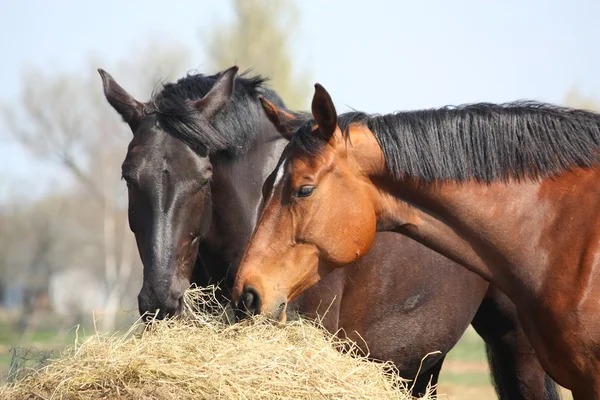How to Balance a Horse’s Diet: Key Principles of Healthy Nutrition

A well-balanced diet directly affects a horse’s health, performance, and overall condition. Whether the animal competes, participates in breeding, or lives a relaxed lifestyle, feeding must be based on the natural needs of the species.
The foundation of a horse’s nutrition is roughage, as fiber ensures stable digestion and supports the gut microflora. Horses must receive sufficient fiber daily; otherwise, their natural digestive rhythm is disrupted. While most horses can obtain adequate energy and protein from hay and pasture, that alone is often not enough for a complete diet.
Modern pastures differ greatly from the natural environment in which wild horses evolved. In the wild, horses moved constantly and consumed a wide variety of plants — grasses, shrubs, and wild grains — ensuring a diverse intake of vitamins and minerals. Today’s pastures usually consist of only a few types of grasses, which are rich in energy and protein but poor in certain trace elements. As a result, even high-quality hay often lacks essential vitamins and minerals that horses cannot produce on their own.
Vitamins play a key role in metabolism, immune response, energy production, and the condition of the skin, coat, and hooves. Minerals are equally essential — they support bone and tooth development, nerve transmission, water and electrolyte balance, and hormone synthesis. Particularly important for horses are calcium, phosphorus, magnesium, and sodium, along with trace elements such as copper, zinc, iron, selenium, and iodine. An imbalance between them can cause health problems, even if the horse appears outwardly healthy.
To maintain a truly complete diet, special balancer supplements are used. These products compensate for vitamin and mineral deficiencies that occur when a horse receives few or no concentrates. Balancers can be daily, for regular use, or targeted, given during periods of higher demand — for example, during intense training, growth, or recovery from illness.
Concentrated feeds have traditionally been used as sources of energy, protein, and micronutrients. However, many horse owners today reduce the amount of concentrates, returning to a more natural, roughage-based diet. This approach benefits digestion, but if the concentrates are cut too drastically, the diet may become nutritionally unbalanced. In such cases, using a balancer helps maintain adequate vitamin and mineral levels without increasing calorie intake.
Over the past decades, the horse’s diet has changed significantly. Modern horses live in confined spaces, experience regular workloads, and often train in a competitive environment — their needs differ from those of wild horses. While a roughage-based diet benefits the digestive system, it requires careful monitoring of nutrient intake.
A balanced equine diet always includes six essential components: carbohydrates, fats, proteins, vitamins, minerals, and water. Each plays a vital role, and the absence of even one disrupts normal body function. The most vulnerable nutrients are vitamins and minerals — their deficiency cannot be compensated by hay alone.
When developing a feeding plan, it’s important to consider not only the type of feed but also the horse’s workload. Sport, breeding, and working horses require more micronutrients than those with a calm lifestyle. The diet must match the horse’s actual energy expenditure and individual physiological needs.
It is also essential to monitor the quality of roughage. Hay must be clean, well-dried, and free from mold and dust. Owners should know how much hay the horse consumes daily and whether the amount is sufficient. Continuous access to fresh, clean water is also mandatory.
A properly balanced diet supports overall health, improves physical condition, strengthens immunity, and reduces the risk of disease. Such a feeding approach not only promotes well-being but also ensures a long, active, and comfortable life for every horse.